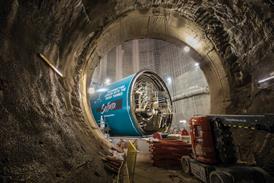This former London Transport depot lay empty for over ten years before being taken over by Monsoon as the site for its national headquarters. The process of transformation took speed, co-ordination and some innovative servicing to meet the client's needs and satisfy the architect.
The first phase of the rejuvenation process is now complete, with the staff from the company's two existing West London offices in Perivale and Lancaster Gate moving in during early June.
Servicing's beaming glory
Services play a large part in the aesthetics of this building as well as the comfort levels. Jim Grace, associate director of m&e consultant Atelier Ten, explains: "The architect wanted to retain the exposed soffits and as much of the industrial feel of the building as possible, so we came up with the idea of using an integrated chilled beam and lighting unit, fed from a central bulkhead."
These specially designed integrated beams – multiple service units – contain all the heating, ventilation and lighting used in the offices. They are deliberately rectangular and metallic and each measures 500 x 500 mm. They were supplied in lengths of 1·4 m.
On each floor a central bulkhead surrounds the central core and the service units feed out from this. To ensure flexibility of servicing the units have been installed at three-metre intervals. "Almost any conceivable office partitioning arrangement will have a chilled beam inside it," assures Grace.
Each beam has the facility for individual control. However room controllers have been avoided and control is via a central system – the client wanted to keep operation simple. This also increases the flexibility of the system as any alterations can be made from this central system and rewiring should be unnecessary. This is helped by the planning of the electrical services: wiring inside the beams is arranged to lead to a single position in each area.
Much off-site prefabrication has been used on the project "for time-saving, but also for quality," states Grace.
"The idea was that as much of the installation would take place in the factory as possible, so that the site assembly would just be a case of fixing into the ceiling and plugging into the ventilation, heating/chilled water and electrics," says Grace.
The use of the service units were ideal for this purpose. Identical units have been used throughout the building, with the required number simply clamped together on-site. This further simplified installation. "It's a learning curve," says Grace, "once the first three or four units were up then it became routine." A Trox specialist installer carried out the initial installation of the msus; the lighting and electrics within the bulkhead were then installed by GK Electric, before the first company returned to finalise the connections.
The same team of workers completed the installation, floor by floor, reducing the need for retraining and ensuring that the speed of installation was maintained. The beams themselves were supplied on a just-in-time basis.
The prefabrication theme was continued with the choice of a packaged plantroom: again for the quality and speed of installation it could bring to the project. And cabling was not forgotten: a modular wiring system was used to speed installation and simplify the process.
Structure and location
"One of the most appealing things about the job was that it wasn't a bog standard office project. It was something special," enthuses Grace.
The structure and its location added to the project's challenges. "It is quite an unusual shape," says Grace. And he isn't exaggerating. The building is made up of a mass of different parts. Much of the original structure has been kept, but some changes were essential to create the space desired by the client. A new entrance was cut in the ground floor level wall and a void cut through the upper ground slab to create a double-height reception area and "more drama". Some of the office areas originally had dividing corridor walls, these were removed to create open-plan spaces for the approximately 300 pc-based staff who will be located here.
The original use of the building for maintaining London Transport vehicles means that it is a very solid structure. "It had to take quite considerable weights," says Grace, which, when creating routes for services pipework and cabling can bring its own challenges. He explains: "There were areas where we had to drill holes through existing walls and slabs, which were constructed of in situ concrete – and fairly chunky concrete at that! That took more time than it would with a more conventional construction – I think the diamond-driller was permanently on site."
Although prefabrication was mainly successful, Grace reports: "There were some areas where it was necessary to do more on-site installation of the service beams than originally intended, particularly in the areas where there are suspended ceilings."
The building's location made it essential for pre-planning and on-site co-ordination. The completed phase sits partially beneath an elevated flyover. To add to the access limitations there is one main route into the site. Most equipment and materials had to be brought on site through a loading bay on the lower ground floor, with some coming in via the building's two entrances.
To add to the co-ordination issues, the fast-track nature of the project meant that the workforce on site was large. "The building was turning over around £1 million a month, which takes an awful lot of workers," stresses Grace. "At its peak there were around 150 workers on site, which can at times cause its own problems when you have a building with not a huge floorplan and only two stairs. It takes a lot of management."
The m&e and plantroom installations were divided into three separate sub-contracts and managed by a single project manager. This approach seems to have worked overall, but co-operation between teams was essential. When a problem arose with assembly of the powersets to the service units, the teams worked together to find a solution. The units were installed and a separate powerset attached alongside. Grace describes this solution as a "workaround" to ensure that the programme was maintained, but acceptable as the maintenance teams can easily reach components. "We were willing to do whatever we could to help the construction team finish the project," he states – surely a sign of close-working.
The use of multiple service units could be set to increase with the attractive low maintenance they offer clients, and with standard installation techniques needed to complete the work, learning the process must surely be a fashion to follow.
Profile
PlayersProject: 179 Harrow Road
Client: Monsoon
Project manager: Jackson Coles
Architect: Alford Hall Monaghan Morris
M&E consulting engineer: Atelier Ten
Main contractor: Sisk
Electrical contractor: GK Electric
Mechanical contractor: Heating & Cooling
Lighting designer: Atelier Ten
Tender date: May 2000
Form of contract: Two-stage JCT 98
Contract period: Ten months
Mechanical
AHUs: Mercury
Boilers: Keston
Chilled beams: Trox
Chillers: Mercury
Control valves: Pegler
Computer room a/c: Daikin
Extract fans: Mercury
Fan coil units: ABB
Flues: Selkirk
Pumps and pressurisation: Mercury
Sound attenuation: Allaway Acoustic
Electrical
BMS: Berkeley Controls
Busbar: MEM
Controls: Trend, Berkeley
Electrical distribution: MEM
Electrical accessories: Wandsworth
Fire alarm/detection: Defensor/Gent
Floor boxes: Electrak
HV switchgear: MEM
LV switchgear: MEM
LTG & power busbar: Electrak
Standby generation: Brentwood
UPS: UPS Systems
Water leakage detection: Raychem
Lighting
Controls: Electrak
Offices: ETAP beams
Conference rooms: Concord
Kitchen: Concord, Iguzzini
Computer: ETAP
Stairs: TEC Lighting
Circulation: Concord:marlin, Iguzzini
External: Crescent, Iguzzini
Prices
Total: £10 million
M&E services: £2.5 million
Source
Electrical and Mechanical Contractor





















